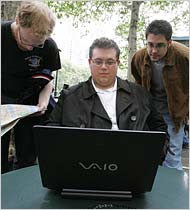
There's some really interesting new research out about credibility of information online:
"Two university researchers, along with a team of experts, are working on a technology that would allow users to assess the credibility of information they find through web searches.
Michael Eisenberg, professor and dean emeritus at the University of Washington, and David Lankes, an associate professor at Syracuse University, received a grant to establish a web site called the Credibility Commons. The site aims to provide computer programs and tools to help users more easily find credible information online.
The Credibility Commons arose out of a conference hosted by the University of Washington's Information School and sponsored by the American Library Association's Office of Information Technology Policy, with funding from the MacArthur Foundation. The conference centered on the credibility of internet information. Participants--who included experts from libraries, education, and other communications fields--sought to determine the scope of the problem, define the existing state of knowledge on the topic, and develop practical steps to address the credibility of information found through web searches.
Eisenberg said his team would like to provide different search capabilities and have educators and others try them out and offer feedback. "Google's page ranking has to do with who else links to that site, and it's quite good related to topic, but no one has done that on the dimensions of credibility," he said. "How do we have those credible sites come up first?"
He added: "Librarians have question-and-answer services, or 'Ask a &' services, where people can contact them and get a response back. Our hypothesis is that a librarian would not recommend a site that's not credible. So, can we somehow harvest all the sites that librarians are recommending and put these into a database and search that, rather than searching the entire web?"
Eisenberg said such a service would be particularly useful for students, who often have trouble finding and assessing the credibility of information online. "That's not filtering or censorship, that's gathering a collection that is selected as appropriate," he said.
There are applications available now that can help users determine the credibility of information they find when searching the internet. TrustWatch, a plug-in that can be downloaded for the Mozilla Firefox and Internet Explorer web browsers, attaches a verification to search results, telling users whether the information is verified by TrustWatch. Eisenberg said there are 10 or 15 different services like this, but users of these services have to question who determines what information is or isn't considered credible.
The Credibility Commons team discussed what its research agenda might be, and some members decided that the research should be a living, continuous project.
"We need a place for people to be able to share information, where we can provide some baseline tools for experimentation and information about credibility," Eisenberg said. The MacArthur Foundation agreed to provide funding, and the web site just recently launched. "It's captured a lot of interest, and a lot of people are contacting us about ideas related to it, as well as collaborations," he said.
So far, the site contains mostly research on the credibility of internet information. In the next few weeks, however, the group hopes to add to the site a daily or weekly listing of the latest credibility news, as well as new tools to help users assess the credibility of information online.
"We'll focus on some things probably more appropriate to a K-12 audience," Eisenberg said. "[But] the scope of our interest is not limited to & higher ed or K-12--we're really interested in everyone, and that creates special challenges. We very much want to have our audience be of the broadest possible focus."
You can read more here.




